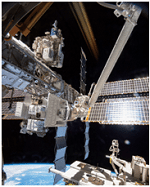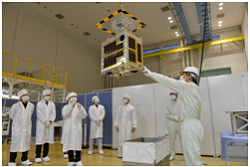Kibo-ABC Member Countries’ News: The Philippines
Last Updated: March 18, 2016

The First Philippine-made 50kg Class Satellite “DIWATA-1” Ready for Launch

J-SSOD on ISS/Kibo
DIWATA-1, the first Philippine-made satellite has been handed over to JAXA at Tsukuba Space Center on January 13, to prepare for its launch to International Space Station into space in April 2016. The diligent students from the Philippines leveraged the technical guidance by Japanese universities to lead this international collaboration project sponsored by the government of the Philippines to succeed. The great success of this project has made its mark on the history of space development in Philippines, which is currently planning for the creation of a Philippine space agency.
Filipino satellite development starts from Diwata-1

DIWATA-1 Installed to deployer case at Tsukuba Space Center
The Philippines often face the risks of natural disasters such as typhoon, hence the needs for the satellite data is increasing. However, as the Philippines did not have their own satellites, the government official says that they had to purchase satellite imagery from other countries costing millions of dollars annually. By having their own satellite, the Philippines can get data 365 days a year and task the satellite to take a picture of a particular location, to obtain information needed rapidly and more easily.
Diwata-1 has several scientific instrument such as the High Precision Telescope (HPT); Space-borne Multispectral Imager (SMI) with Liquid Crystal Tunable Filter (LCTF); and the Wide Field Camera (WFC). These instruments will monitor the surface of the lands and waters of the Philippines, to estimate damages from natural disasters, monitor vegetation changes, forecast weather and similar activities.
Collaboration with Japan for development and deployment
The development of Diwata-1 is part of the Department of Science and Technology’s Philippine Scientific Earth Observation Micro-Satellite (PHL-Microsat) Program which was initiated in 2014.. The project decided to choose Japan as a partner to develop their first Filipino-made satellite, and sent nine engineers and students from the DOST-Advanced Science and Technology Institute (ASTI) and the University of the Philippines to two Japanese universities, Tohoku University and Hokkaido University to learn satellite development. The program is also intended to building capacity of young engineers and students in the Philippines. The microsatellite development was completed in December 2015, an astonishing speed for developing satellites. The satellite will be deployed from JEM Small Satellite Orbital Deployer (J-SSOD) on Japanese Experiment Module “Kibo” in the International Space Station (ISS), in cooperation with JAXA.
The second satellite, PHL-Microsat-2 or DIWATA-2, is already under development and targeted to be launched in late 2017. 
Official conference; Philippines the Department of Science and Technology (DOST), Embassy of Japan in the Philippines the University of the Philippines, Tohoku University, Hokkaido University, and JAXA.
Comments are closed.